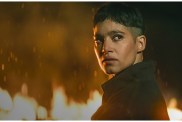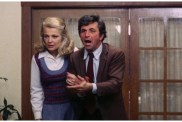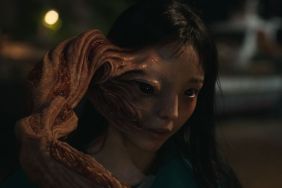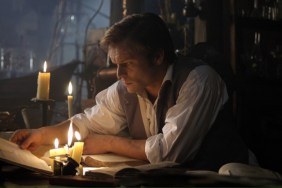The Frankenstein-esque creature feature

The themes of man getting his grubby mitts into God’s business – notably, creating life – have been explored in the horror genre for well over a century. Mary Shelley’s “Frankenstein,” published in 1818, has been the archetypal model for storytellers; used for, naturally, countless adaptations and the likes of Re-Animator and Jurassic Park (hell, even Frankenhooker). In an all too familiar scenario, a good-intentioned – possibly unhinged – scientific mind births a creature or being (“made with my own hands!” said mortal creator might utter) that, in time, turns on their “father” or “mother.”
Filmmaker Vincenzo Natali picks up this torch in Splice. Adrien Brody (Predators) and Sarah Polley (Dawn of the Dead) star as Colin and Elsa, respectively, rock star geneticists who splice human and animal DNA to create “Dren” a humanoid that evolves in various forms. Is there danger involved? But of course.
Natali, who directed the claustrophobic Cube in 1997, has been at work on Splice for a decade. Through development, his creature feature found an ally in production Guillermo del Toro (Pan’s Labyrinth). Although in production since 2007, Splice finally made its premiere at Sundance on January 22 and opens in theaters on June 4 from Warner Bros.
Shock Till You Drop spoke in-depth with Natali about his film, furthermore its creature and Frankenstein-like themes in Los Angeles just prior to its Sundance debut.
ShockTillYouDrop: This is a film that’s been gestating for some time, so the idea must have held a certain strength for you to want to see this come to fruition. Where did this willpower to see it through come from?
Vincenzo Natali: It’s a life-long love of creatures and creature films. It was originally inspired long ago by a real scientific experiment where in a mouse was created that, by all appearances, had a human ear on its back. It wasn’t actually a human ear. The cartilage was artificially made underneath the mouse’s skin, but the notion was you could grow organic materials on this mouse that could later be grafted onto human beings. It was such a strange image, a shocking image, like something out of a Salvador Dali painting. It reinvigorated my interest in genetic engineering, not that it was a form of that, but it was definitely pointed in that direction. But that’s where it all began and it’s taken me ten years to get here.

Shock: Time could be said to be on your side, because while you’re in development on this thing, science is making new strides making your film more plausible.
Natali: I’m afraid it’s actually outpacing myself. I keep referring to this, but it took less time for them to map the human genome than it took me to write the script. But you’re absolutely right. I think part of the reason Splice happened when it happened was because not only of the development in the real scientific world, the real realm of genetic engineering, but because the film science, the film technology, evolved so I could create a creature like Dren. But at a modest cost.
Shock: We’re jumping ahead, but we might as well get to the good stuff. Talk about the Dren creatureâ¦
Natali: She’s a fascinating creature because she changes. She goes through a number of quite dramatic, physical transformations throughout the film. As much as possible, I tried to be as biologically plausible as I could. I wanted Dren to be a creature you could really believe in. That’s why, as much as I could, I used prosthetics and real people – just digitally augmented them. Dren is a creature you could believe in and she’s a creature you can love. That was the goal. [laughs]
Shock: And where did you find the right actress to play her?
Natali: We started by casting in Paris. I was looking for someone who was very beautiful, but not in the traditional sense. I wanted someone who was a bit androgynous, actually. I discovered this amazing French actress named Delphine Chanéac. And that’s one more reason why I’m glad I didn’t make Splice ten years ago, Delphine probably would have been ten years old. She’s the reason Dren works. It’s her performance. She’s extraordinary and in the history of creature films, she creates a truly memorable monster.
Shock: Is there a creature you liken her that perhaps shares her characteristics?
Natali: To be perfectly honest, and I hope I’m not being too boastful, but I think she’s entirely unique. I don’t think there’s anything quite like her on film. I think most creature movies tend to treat their creatures one-dimensionally. And Dren, as a character, is well-rounded. At points very sweet and gentle. At other times very vindictive and cruel. She’s a complicated characters and we watch her grow from a single cell to her full adult form. It’s a really amazing character arc. Delphine, as an actor, is a unique presence. There’s no one out there who quite has her quality. She can be innocent and highly sophisticated and dangerous.

Shock: You obviously need to balance that out with a human element which you have in Sarah and Adrien’s characters. Do they represent different sides of Dren’s personality?
Natali: Really, this movie is a relationship story as much as it is a creature story. Clive and Elsa are equally complex characters and their motivations for creating the creature are entirely different from one another, but intriguing each in their own way. The underlying notion of my movie is to find humanity in the monster, and the monster in the humans. I cast Sarah and Adrien because even though their characters do despicable and questionable things over the course of story, you never lose sympathy for them. Because they’re so appealing and so human. We can always relate to them even when we’re seeing their darker side. It’s an exploration are all of those things. On one hand their motivated by the pure science of creating Dren – they’re working for a pharmaceutical company – but there are personal reasons. I needed actors of their caliber to pull that off.
Shock: I have to ask, the character names of Clive and Elsa. Is that a nod to the actors Colin Clive and Elsa Lanchester from the James Whale films?
Natali: Ah, very good. You’re totally right. I grew up with the James Whale Frankenstein films and I’m a huge fan of them. Also, Berni Wrightson’s “Frankenstein.” It’s woven into the fabric of what Splice is. At the same time, I was very aware that in doing a Frankenstein story, I wanted to posit it into the 21st century. I made some references like that, but that’s more out of respect. I didn’t make it a template for what Splice would be. For the first time, recently, I read Mary Shelley’s book. I was fascinated to see how different it was. In some respects, it does have some similarities to my film.
Shock: I respect Shelley’s source material, but I’m a bigger fan of Whale’s interpretation. Even those films that try to stick close to the book don’t do it for me.
Natali: You can see why the James Whale version does work. It would be a terrible thing if the monster could speak, he remains mute.
Shock: Until the second film. But he’s not so eloquent.
Natali: Our creature is mute, too. The Kenneth Branagh Frankenstein is a disaster. A terrible movie, out of an attempt to stay true. It’s best to remain a novel.

He’s our godfather. He’s Dren’s godfather. He really supported me and the project from the very beginning and his approach was, “I’m just there to help you do what you want to do in any capacity you want me to.” But he’s clear about not putting his stamp on it, imposing anything on it. I think he’s the great impresario of science fiction, horror and fantasy. I think out of the goodness of his heart, and a love for the genre, he has helped a lot of filmmakers, myself included. I’m impressed by how available he was for us. The guy’s so busy. I don’t know, exactly, he does it. When we needed help getting an actor or reaching a person, he would do it for us. He’s a wonderful person and we were lucky to have him on our side.
Shock: How many design incarnations did Dren go through in pre-production? It takes time for a director to find the right choice for a creature with one look. Dren goes through multiple stages which I presume increased the workload and varieties.
Natali: Since I had a decade to prepare for this film, I had time to work on it. I worked with an incredible group of artists on the process and it was very much a collaboration until the end. It was a challenge because when people looked at the script they’d say, “Oh, there’s just one creature in it. How expensive can it be?” Little did they know it was a Chinese puzzle and it’s much more technically complicated than it appears on the surface. Dren goes through four or five-ish very different configurations, and yet we want to feel the connective tissue between these configurations. There needed to be a biological logic to how she evolves. This is the amazing thing about the digital age. That design process can take you right up until post-production. We were tweaking things until the bitter end. I don’t want to talk too much about how we pulled it off because it might spoil the illusion, but we made an attempt to give Dren a unique identity in each stage. Keep a connection between each form but keep the audience surprised in terms of how she would change. Her evolution forms the narrative mind of the movie and it grows from there.
Shock: What about your state of mind through the process? Ten years of sticking by a vision – you must have had some dark days where you almost wanted to give up.
Natali: I worked on this thing on and off and at some points I did think it was never going to get made. The reason for that is simple. It’s not a cheap movie. It has a double-whammy of also having some very taboo material in it. Not to give too much away, there’s sex in this movie and major studios are not comfortable with that. It took a French company, the French culture who is not at all prudish when it comes to back something like this, to make it happen. Ten years ago, when I started, it all fell apart, but it eventually worked out.

Shock: What are you anticipating at the Sundance screening?
Natali: I think at this stage, I hope I disturb a lot of people. If I haven’t done that, I haven’t done my job. That’s what this movie sets out to do. It takes people to places they might not be comfortable with, but for me as a filmmaker, I think it’s kind of thrilling. That’s what horror films should do. The strength of horror as a genre is that it allows us to traverse into places that are frightening, that we are not comfortable visiting in our every day life. But let’s do lurk. This is an oedipal horror movie that taps into things that have been discussed for thousands of years. One of the things that excited me about making Splice are those notions of animal-human hybrids and now we have the technical tools to make them a reality. The movie plugs into highly-charged things that are current. I don’t know what’ll happen at Sundance. Maybe we’ll get boo’ed off the stage. [laughs]
For clips from the film click here!
Source: Ryan Rotten, Managing Editor










